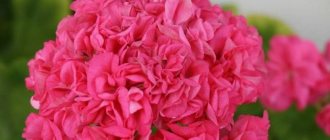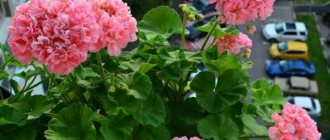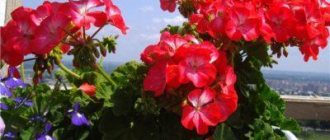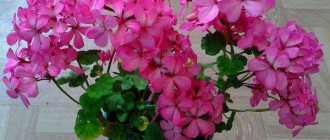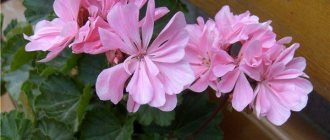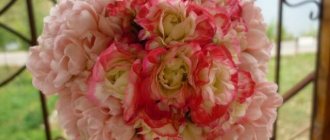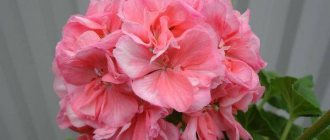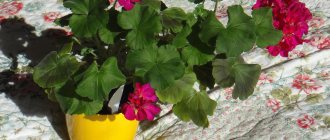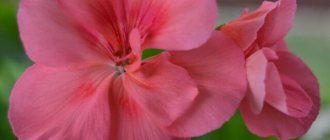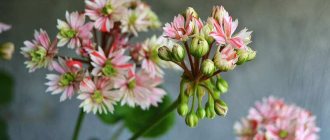Pelargonium is a plant that beginning gardeners mistakenly associate with geranium. In fact, although both flowers belong to the same family, they are different in their genus, and therefore cannot be crossed. Another important point: geranium is native to the northern regions, and pelargonium is native to the southern regions. However, it is not so much the origin that is important, but the differences in the requirements regarding the maintenance and care of plants. Gardeners call one of the most beautiful representatives of pelargonium such a group of plants as pelargonium Odencio Symphony.
Similarities and differences between the two varieties
Representatives of the aristocracy among geraniums, Ingrid Grycksbo pelargonium and Ingrid pelargonium, look similar to each other, but have some varietal differences.
Pelargonium Queen Ingrid is the real pride of any gardener
Both are classified as dwarf zonal and are highly decorative. However, Ingrid Grixbo's pelargonium flowers have a richer orange hue. In the middle there is a snow-white core. The leaves are unevenly colored: the central part is light green, the edges are rich in color. The bush itself is neat and does not need shaping.
Description of pelargonium Queen Ingrid:
- Large double flowers. The petals are soft pink, often decorated with green or white spots, but can also be monochrome.
- The leaves are rich green, the shade is uniform over the entire surface.
- The root system is branched.
The flowering period is from early March to the second half of October.
Note! For long-lasting elegant flowering, it is important to keep the bush in the cold during the winter months (December and January)
History of appearance and description of the variety
The beautiful Odensjo Symfonia was bred by breeders from a nursery called Rockdala, located in Sweden. The flower is characterized by the presence of tight inflorescences of a bright pink hue. The leaves are densely double, rich green.
Odensjo Symfonia - pelargonium, which is part of a large group of the same name
For your information! According to the description of pelargonium, Odensjo Symfonia lends itself well to pruning and forming a bush, is not afraid of sudden temperature changes, and is resistant to short-term cold snaps.
Varieties and their descriptions
The Odensjo Suzie Wong variety is represented by several species.
"Symphony". Flowers of a rich pink hue, collected in inflorescences. The leaves are light green. It is unpretentious to environmental conditions, blooms well and can be molded.
Black Mamba. It is a dwarf plant with double inflorescences of pink colors. The leaves are brown, with a thin greenish border.
Bernadette. It is a dwarf plant with double white and pink inflorescences. In sunlight they become brighter. In spring it blooms the fastest.
Rodluvan. Compact bushes with double flowers of a bright red hue, well formed. The inflorescences of "Rodluvan", compared to other species, are much larger.
Ice Frozen Campari. It is a semi-double pelargonium. The inflorescences are white with red and pink splashes, the leaves are yellow. The bushes are quite miniature and fluffy.
Made in Sweden. Presented as bushes with dark leaves. The flowers are small and resemble carnations in appearance.
Ljus Och Varme. Refers to terry pelargoniums. The inflorescences are pinkish-white caps. But these two shades do not mix.
Stilla Flirt. It is represented by semi-double inflorescences of a pale pink hue with a yellow center. The leaves are rich green with a dark zone. The combination of dark foliage and delicate flowers looks very beautiful. A compact bush that branches well.
Sophie Arden. This is a species with double pink flowers. The inflorescences are dense and resemble umbrellas. Leaves are green in color with a bright zone.
"Madame Bovary." It is a miniature bush with bright red inflorescences. After pruning, growth slows down.
Omma Ogonkast (translated as “tender gaze”). Has beautiful soft pink flowers. The main feature is that the leaves dry out and shed in the heat.
Tintomara. Refers to semi-double. The leaves are yellow with a large brown zone. Flowers of pink shades with crimson splashes.
Eloise. Dwarf plant, compact. The leaves are small and have a well-defined dark zone. The flowers are a muted crimson hue.
Kate. It is a species that is undemanding to growing conditions. The variety has bright shades of flowers and blooms profusely. Young inflorescences are particularly lush and beautiful.
Ogonocast. They are miniature bushes with bright green foliage and pink-white flowers.
Tango. It is a fairly dense bush with green leaves. The flowers are semi-double, quite large, pink-lilac in shades interspersed with crimson.
Sound of Silence. Presented with white flowers with a greenish tint. The bushes are miniature and do not require shaping.
Florentina. This is a dwarf pelargonium, characterized by decorative leaves of yellow-green color with a faint dark zone. The flowers are white, with a thin pink border, veins and inclusions.
Vanessa. A miniature bush with double inflorescences of bright pink color.
Vivaldi. It has compact inflorescences of a pale pink hue with a bright crimson border around the edges.
Even an inexperienced gardener can care for pelargonium. This is due to the fact that this culture is absolutely unpretentious and does not require any special conditions. The most optimal temperature for a flower is normal room temperature.
This type of peony does not need moisture, so there is no need to spray the flower. Periodically, the crop needs to be well watered, but in no case should the liquid stagnate. Therefore, care should be taken about drainage.
Pelargonium can be fertilized with standard mineral fertilizers for indoor plants; it does not tolerate organic matter.
Odensjo trish pelargonium
Good day to everyone who has visited the pages of my site.
in pelargoniums 2016 I want to show both the oldies of my collection and the new varieties.
Edwards Elegans. Large, white-pink flower caps with jagged edges of the petals. Delicate but expressive flowering of this variety. The bush does not cause problems, it forms well. This variety is part of my main collection. Not all varieties of the Edwards series performed well in my conditions content, but this particular variety has a permanent residence permit.
Ludwigsburger Flair.. my good old variety, which still appeals to me now. One of the first to appear on my windowsill, lives to this day. Was, is and will always be! I love its gentle tints in the caps, the greenness of the leaves and the tractability of the content.
new Greenacres , an upstart with long peduncles, the bush needs to be formed immediately, the variety is recognizable both by the bush and the flowers - this is a big plus. The flowers are porcelain-white, the petals are dense, wavy, the first caps are very large, lacy. There is also a minus. The variety still tries after pinching drive the top into two, three branches at best.
Calypso's favorite , this spring almost all the cuttings taken from the plant in February took root; last year there was only one rooted cutting from this variety over the summer. As soon as the variety started flowering, and it blooms profusely and for quite a long time, cuttings from it practically do not take root .
Lara Harmony is a wonderful variety that can bloom well both on the window and on the street. The photo shows a heavily pruned mother plant in a pot growing on the street. It quickly grew...blooms.
new varieties this year
BROOKSIDE KATERINA . Beauty, beauty and beauty again! Bright, bold in color, with a white backlight radiating across the petals from the center of the flower... you can notice this immediately, expressive and spectacular pelargonium... I really liked it. Large flower, neat cap. Grows slowly, forming a fluffy bush.
Gerda , very helpful in the bush, strong, stocky, well formed. The caps are large, full-bodied, voluminous.
another new one. Odensjo Madame Bovary
As soon as she showed the first flower... that's it! it was love, right away... this variety is very difficult to photograph. Delightful, deep and velvety red and dark foliage. The variety is very beautiful and contrasting! The inflorescence is not large, but this is for now, the plant is still young.
Anita , blooms from cuttings, sets flower stalks well, very delicate in color, fluffy inflorescences...balls of roses!
Prince Gustav...a prince he is a prince!
I probably took the shape of a leaf from the mother tulip, also slightly curled and harsh to the touch, medium in size, shiny. Not lazy, it lays flower stalks actively, even very actively.
PAC Viva Madeleine, this year, the February cuttings are blooming.
Misty…
Misty...very spectacular flowering, the white underside on a soft orange inflorescence captivates anyone...but it can be pretty stubborn, maybe it depends on the season or on the cutting...I don’t know for sure. Sometimes it blooms from a cutting, and sometimes it will form a good bush, but it will flourish mediocre. In This year the bush is good and there were two waves of flowering, but it began to expose the bottom of the bush. This variety needs a greenhouse, there it can be a real beauty! I will never give up this variety, it is too extraordinary and there are few like it.
Diseases and pests
In general, all pelargoniums are characterized by resistance to disease; they are completely unpretentious. The main reasons for poor health are considered to be non-compliance with the watering regime, insufficient or excessive air humidity. A plant weakened by these factors can be attacked by viruses and insects - aphids, mites, caterpillars.
To prevent serious problems, you should take care of the flower. The affected leaves must be removed; new shoots will appear in their place later.
It is not surprising that the Odensjo Symfonia group of pelargoniums was loved by the aristocrats of the 18th century. All flowers are distinguished by their lush bloom, unique aroma and unpretentiousness, combined with high decorativeness.
Pelargonium
- Anthurium (42)
- Balsam (0)
- Begonia Elatior (6)
- Bromeliad (0)
- Heather (0)
- Carnation (0)
- Hyacinth (0)
- Hibiscus (1)
- Gloxinia (0)
- Guzmania (6)
- Other blooming (41)
- Kalanchoe (23)
- Camellia (3)
- Lily (0)
- Daisy (0)
- Pelargonium (11)
- Primrose (1)
- Poinsettia (3)
- Rose (7)
- Sinningia (2)
- Spathiphyllum (21)
- Violet (9)
- Fuchsia (0)
- Chrysanthemum (9)
- Cyclamen (13)
- Schlumberger (9)
- Bracteama (0)
Buy pelargonium
Pelargonium is a species of the Geranium family that is grown indoors. This is a very beautiful, profusely flowering plant with lush foliage and a pleasant aroma. Pelargonium is very unpretentious, so it is great for offices and public places, and in an apartment you can always find a corner to enjoy flowering even in the middle of winter.
Buying pelargonium in the Darwin online store is simple and convenient. We have a large selection of indoor pelargonium varieties. Store managers will contact you to clarify your order and select a specific variety of pelargonium for you. Our indoor plants are grown in the best nurseries in Europe; they show high survival rate and viability.
You can order the delivery of indoor plants by our transport service in Moscow and the Moscow region. You can also pick up pelargonium yourself from our garden hypermarkets located in Solnechnogorsk, Zelenograd, Podolsk and Pushkino.
Buy pelargonium in Moscow
Geranium and pelargonium are different plants. They belong to the same family, but geranium is a garden plant that can survive our difficult winters, when thaws alternate with severe frosts. And pelargonium is a lover of warmth and light, so it is grown exclusively indoors. In the summer you can take it out into the garden, but before the cold weather sets in, be sure to return it to the warmth and comfort of your home environment.
Pelargonium is so easy to care for that anyone, even a novice gardener, can handle it:
- • Pelargonium loves bright light, but in summer it must be protected from direct sunlight. They may cause burns;
- • In summer, it is better to take pelargonium out into the garden, placing it in a well-lit area;
- • The plant loves moist soil; it is better to water it often, but little by little. Stagnation of water is extremely undesirable; you need to take care of this when replanting the plant by arranging good drainage in the pot;
- • Pelargonium is undemanding to air humidity; it is important that moisture does not fall on the leaves and flowers of this indoor flower;
- • Comfortable temperature for the plant – room temperature;
- • Feeding for pelargonium is needed once every 2 weeks. It is necessary to use mineral fertilizers for flowering indoor plants.
Planting Pelargonium Lake
Lake - pelargonium is unpretentious, but it is important to choose optimal conditions for the plant
Choosing a place and pot
Like all house geraniums, Laque prefers light areas on the south side
However, it is very important to protect the “green pet” from direct UV rays by lightly shading with tulle. A draft is unacceptable, but the crop loves fresh air, so constant ventilation must be ensured.
The pot should be selected based on the size of the bush, taking into account the fact that this geranium does not like “relocation”. Rounded models up to 15 cm in diameter and up to 20-30 cm in height look beautiful. But these dimensions are relevant for an adult plant. To plant the cuttings, you can choose a regular plastic cup.
Note! The diameter of the container should not be too large, otherwise pelargonium will begin to develop a root system, which will affect the green mass and flowering
A very beautiful plant will certainly respond to proper care and will thank the grower with stunning caps of inflorescences
Priming
A drainage layer is required, for example, from gravel, expanded clay, vermiculite. It will help prevent the roots from rotting. You can buy ready-made soil for geraniums. Or mix it yourself from turf, humus and coarse river sand.
All about pelargoniums Odensjo
Colleagues, an earnest request to everyone! Please upload small photos to the forum (no more than 800 pixels on the wide side). We will be forced to delete large photos, for example, 2000x3000 pixels by default. BE SURE TO READ THE FORUM RULES!
Volunteer help is required in the greenhouses of the Main Botanical Garden of the Russian Academy of Sciences (Moscow, Botanicheskaya Street).
If you have the desire and time, then you can also help in this difficult matter.
Volunteers work in the garden on Mondays and one Sunday a month. Leader of the volunteer group in greenhouses: Evgeniy Gusev
. You can contact Evgeniy to clarify the time and place of the meeting on the next volunteer day. More details: https://vk.com/moscowtropics
Active participant
Group: Users Messages: 285 Registration: 7/28/2013 From: Ufa User No.: 12924
Hello everybody. My name is Oksana. I want to tell my story of meeting beautiful Pelargoniums. In my case, this love was not inherited from my grandmothers and was not absorbed with my mother’s milk. It so happened that our family was not keen on house flowers. Don't be surprised, this happens too. My passion for pelargoniums began about a year ago, when, after visiting another flower exhibition, where I came exclusively for violets, I miraculously acquired my first zonal pelargonium Jacey. It so happened that the “culprit” of my pelargonium addiction, without knowing it, was Irina K, for which a huge THANK YOU to her. And away we go. Purchasing new varieties, hanging out on the “Pelargonium-club” forum where I eagerly read everything and everyone, meeting new people who are passionate about pelargoniums: Osya-Olga, Geranka-Anzhela, Gts_09-Elena, maugli-Larisa - I express my deep gratitude to everyone. Exclusively all pelargoniums came to me, so to speak, from a young age, that is, cuttings and grew up before my eyes. Time has passed since I bought my first pelargo and now I want to share my joy with everyone who comes to visit me. So, welcome.
Denise - everything has already been said about her more than once, one word is a favorite, she holds roses.
Dodd`s Super Double – giant pelargonium. Definitely not for home use. At the dacha in a large pot it shows itself excellently. The leaves, frankly, are burdocks, the bush grows huge, but I forgive everything for the flowers.
I love the “eyes” for the variety of interesting combinations of colors in one flower, for the independent correct formation of the bush, earlier flowering, almost from the cutting. It's a shame they're falling out.
Pac Penve is a tireless flowerer, compact and still blooming to this day. I'm tired of fighting with it, cutting off flower stalks. Overwinters on a south window without lighting. Apparently everything is fine. So it's 1:0 in his favor.
Americana White Splash is a compact pelargonium, I really like this color. The flowers are large, but there is a drawback - they fall apart. And since my pelargoniums are in the country during the warm period, this drawback is almost invisible to me. Along with Lavender Orchid balsam.
Reproduction
It is carried out in two ways - seeds and cuttings. The first option is considered the most difficult; it is almost impossible to obtain seed material on your own; they should be purchased from a reliable flower growing store. It is much easier to pick a cutting from the mother bush and root it. Sequencing:
Carefully cut off 1-2 top shoots up to 8 cm long from the donor plant. Place them in the Epin growth stimulator. Plant in nutritious soil, water carefully and cover with a plastic bottle to maintain temperature and humidity.
Ventilate the sprouts every day and moisten them if necessary.
Diseases and pests
Yellowed pelargonium leaves indicate that the plant does not have enough light. If they begin to wither and fall off, then this is a sure sign of waterlogging in the soil; the plant must be promptly replanted.
Note! The main pests of the variety are aphids and whiteflies; complex insecticides are used to get rid of them. Such is the amazing pelargonium, Quinn Ingrid, whose soft pink double flowers really evoke associations with something regal and aristocratic
And the Grixbo variety, with its brightly colored petals, can compete with almost any domestic flower
Such is the amazing pelargonium, Queen Ingrid, whose soft pink double flowers really evoke associations with something regal and aristocratic. And the Grixbo variety, with its brightly colored petals, can compete with almost any domestic flower.
Caring for pelargoniums:
– regular pinching of shoots to form bushes of the correct shape, – constant removal of fading flowers,
– mandatory application of complex fertilizer at least 2 times a month during the growing season,
– adding magnesium sulfate (magnesium sulfate) to fertilizing to prevent yellowing of leaves, especially for acidic soils (peat) and plants that do not receive enough light,
– ensuring a dormant period for the plant in a cool, bright place with minimal watering, without fertilizing and pinching in the autumn-winter period (November-December).
For open ground, I grow pelargoniums from seeds purchased in the store in the spring, or collected from my own grown plants.
In my outdoor pots, several varieties of ivy-leaved pelargoniums bloom annually, which I propagate only by cuttings.
I do not collect varietal pelargoniums, but it is still impossible not to have several varieties of these unusually beautiful flowers, so on the windows of the veranda (I do not plant varietal pelargoniums in the ground) there are pelargoniums from famous nurseries, which I propagate by cuttings and can sometimes offer to fans to purchase rooted seedlings in cups:
ErasVictoria is a dwarf zonal pelargonium bred by the ERA Garden nursery (Sweden). The flowers are large, despite the small leaves, of an unusual shape with elongated petals of a soft white-pink color.
Eva Tingstrom, owner of the ERA Garden nursery, which is located in the town of Ekero in Sweden, specializes in growing species of pelargonium.
Flower exhibitions are held annually in Stockholm, where seedlings from the ERA Garden nursery occupy a leading place.
Odensjo Appolonia (photo above) - pink double flowers of zonal pelargonium from the Rockdala nursery, selected by Monica Birgersson, who lives in the town of Odensjo in Sweden, a whole series of pelargoniums is named after this town.
Bill s Gem – semi-double zonal, dwarf pelargonium, soft pink color from Sutarve nursery.
The nursery Sutarve Pelargonbutik (Sutarve) is located in Sweden on the island of Gotland in the Baltic Sea and has been specializing in the cultivation and breeding of varietal pelargoniums for more than 14 years.
Victoria Andrea (photo above) is a zonal tulip-shaped pelargonium of dark red color with white strokes from Michels nursery.
The owner of the Michels nursery, Katrien Michiels in Belgium, has been growing pelargoniums for several years, along with a huge collection of fuchsias that her father grew.
Zonal pelargoniums also have varieties with rosette flowers. These are rosebuds - the most beautiful zonal pelargoniums. The flowers are small, but in full bloom they look like a ball of roses.
Red rosebud - red roses (I don’t know the varietal name).
The smallest group of zonal pelargoniums is Carnation flowered Zonal Pelargonium:
DianaPalmer - extraordinarily beautiful, double, with large salmon flowers and jagged edges of the petals.
Nursery products: species and varietal pelargoniums can be purchased directly at exhibitions, in flower shops, ordered on the nursery website and, of course, from pelargonium collectors in our country. Pelargonium, like any flower, has its fans, who buy this beauty abroad for quite a lot of money and propagate it. Thanks to them!
Other popular varieties of pelargonium from the Odensjo series
The Odensjo series also includes other varieties. They differ from each other in the color of the petals and the type of flowering. Care is almost identical.
Sound of Silence
Pelargonium Odencio Sound Silence is characterized by rather slow growth. The bushes of the plant are compact and neat. The flowers are characterized by a delicate white tone with a subtle green tint. The root system is small, and therefore the flower needs regular watering.
Symphony - pelargonium variety Sound Silence
Suzie Wong
This variety is characterized by double flowers of bright pink, deeper than the standard pelargonium Odensjo Symfonia. The plant is not capricious, it only needs a lot of diffused light and timely irrigation.
Rodluvan
The luxurious flowering of the plant cannot leave anyone indifferent. Bright red flowers appear on dense bushes.
Note! The plant does not need frequent pruning
Bernadette
This variety is dwarf. Bernadette differs from other varieties in the surprisingly delicate pink tone of its petals.
Hummingbirds Egg Butterfly
Opened flowers delight with a rich pinkish-lilac hue. In combination with variegated leaves it looks very impressive.
Ice Frozen Campari
Flowers of a juicy lilac tone with bright spots and a contrasting core, dense green leaves - this is what makes Ice Frozen Campari a popular variety among gardeners.
Lynn Palmer
Ideal for growing indoors. The petals of the opened flowers are very decorative, they are semi-double, there is a soft gradient: from boiling white to purple and green.
Madame Bovary
This variety is loved by gardeners thanks to its bright red flowers collected in small bouquets. The variety may lose its decorative properties if it does not have enough daylight.
Pelargonium Odensjo Symfonia - description
Pelargonium is most often associated with Geranium. Although flowers belong to the same family, they are different in genus and cannot be crossed. Pelargonium appeared in the southern regions, and its named sister - in the northern regions. It is not the origin itself, but the differences in care preferences that are important when breeding geraniums or pelargoniums.
History of the appearance and description of pelargonium Odensjo Symfonia (Odensio Symphony)
Pelargonium Odencio Symphony appeared in the Swedish nursery Rockdala. A characteristic feature of the standard is the rich pink color of the tight inflorescences. The leaves are densely double.
The difference between the flowers can be seen in the leaves and inflorescences; only the seed pods are similar
On a note! The plant is easy to prune when forming a bush, and is resistant to low temperatures.
Other popular varieties of pelargonium from the Odensjo series
Symphony pelargonium has a number of varietal representatives, among which you can choose a plant based on color and type of flowering. The most popular varieties:
- Sound of Silence. Pelargonium Odencio species Sound Silence grows slowly, the bush is compact, and the flowers are distinguished by a delicate white color with a greenish tint. The crop should be watered carefully because it has a small root system.
- Suzie Wong. Susie Wong differs from the Odencio standard in the deeper and richer pink color of the double petals.
- Rodluvan. It has bright red flowers, bushes well, and does not require frequent pruning. The variety is characterized by voluminous inflorescences, which makes it luxurious.
- Bernadette. One of the most delicate flowers of light pink pastel. The plant belongs to the dwarf species.
- Hummingbirds Egg Butterfly. The subspecies with an intricate name attracts attention with its rich lilac-pink color. Large flowers contrast with variegated green leaves.
- Ice Frozen Campari. Zonal pelargonium stands out with lilac flowers, which complement the bright inclusions on the petals and the core.
- Lynn Palmer. The flower is suitable for growing in pots. Petals are semi-double with a color gradient from white to purple and green.
- Madame Bovary. Bovary attracts attention with its expressively bright red color. Inflorescences are collected in large bouquets.
- Stilla Flirt. The smallest and most elegant variety from Odensio. The soft pink color is reminiscent of the gold standard of this type of pelargonium.
Pelargonium Bernadette perfectly reveals and complements the main view
Planting a flower
When growing a flower in the garden, you need nutritious soil mixed with clay. For the potted version, use a mixture of peat and sand.
Note! Pelargonium Odensjo Symfonia can bloom at temperatures of +10... +12 degrees and needs a greenhouse in the autumn-winter period.
Caring for Pelargonium Odencio
The best temperature for the plant is about 20 degrees Celsius. The flower does not need spraying. It is important to maintain moderation in watering and use drainage.
Flower propagation
The plant is propagated using cuttings that have at least 3 leaves when pruned. For small and dwarf species, the cutting height should be up to 4 cm, for tall ones – up to 7 cm.
